
303-D121 or equivalent

205-153 (T80T-4000-W)

310-206

303-409 (T92C-6700CH)

303-1247/1

307-005 (T59L-100-B)

310-S039 (T90T-9550-S) or equivalent

303-D055 (D85L-6000-A) or equivalent

303-1248
SECTION 303-01B: Engine — 3.5L GTDI
| 2014 Flex Workshop Manual
|
DISASSEMBLY
| Procedure revision date: 05/02/2013
|
 | 3 Jaw Puller
303-D121 or equivalent |
 | Handle
205-153 (T80T-4000-W) |
 | Remover, Fuel Injector
310-206 |
 | Remover, Oil Seal
303-409 (T92C-6700CH) |
 | Remover, VCT Spark Plug Tube Seal
303-1247/1 |
 | Slide Hammer
307-005 (T59L-100-B) |
 | Spring Lock Coupling Disconnect Tool
310-S039 (T90T-9550-S) or equivalent |
 | Strap Wrench
303-D055 (D85L-6000-A) or equivalent |
 | Tool, Camshaft Holding
303-1248 |
| Item | Specification |
|---|---|
| Motorcraft® Metal Surface Prep
ZC-31-A | — |
| Motorcraft® Silicone Gasket Remover
ZC-30 | — |
 WARNING: Do not smoke, carry lighted tobacco or have an open flame of any type when working on or near any fuel-related component. Highly flammable mixtures are always present and may be ignited. Failure to follow these instructions may result in serious personal injury.
WARNING: Do not smoke, carry lighted tobacco or have an open flame of any type when working on or near any fuel-related component. Highly flammable mixtures are always present and may be ignited. Failure to follow these instructions may result in serious personal injury.
 WARNING: Do not carry personal electronic devices such as cell phones, pagers or audio equipment of any type when working on or near any fuel-related component. Highly flammable mixtures are always present and may be ignited. Failure to follow these instructions may result in serious personal injury.
WARNING: Do not carry personal electronic devices such as cell phones, pagers or audio equipment of any type when working on or near any fuel-related component. Highly flammable mixtures are always present and may be ignited. Failure to follow these instructions may result in serious personal injury.
 WARNING: When handling fuel, always observe fuel handling precautions and be prepared in the event of fuel spillage. Spilled fuel may be ignited by hot vehicle components or other ignition sources. Failure to follow these instructions may result in serious personal injury.
WARNING: When handling fuel, always observe fuel handling precautions and be prepared in the event of fuel spillage. Spilled fuel may be ignited by hot vehicle components or other ignition sources. Failure to follow these instructions may result in serious personal injury.
 WARNING: Clean all fuel residue from the engine compartment. If not removed, fuel residue may ignite when the engine is returned to operation. Failure to follow this instruction may result in serious personal injury.
WARNING: Clean all fuel residue from the engine compartment. If not removed, fuel residue may ignite when the engine is returned to operation. Failure to follow this instruction may result in serious personal injury.
NOTICE: During engine repair procedures, cleanliness is extremely important. Any foreign material, including any material created while cleaning gasket surfaces that enters the oil passages, coolant passages or the oil pan, may cause engine failure.
NOTICE: Whenever turbocharger air intake system components are removed, always cover open ports to protect from debris. It is important that no foreign material enter the system. The turbocharger compressor vanes are susceptible to damage from even small particles. All components should be inspected and cleaned, if necessary, prior to installation or reassembly.
NOTE: A clean working environment is essential to prevent dirt or foreign material contamination into the fuel rails.
NOTE: For additional information, refer to the exploded view under the Assembly procedure in this section.
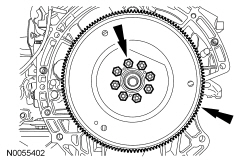
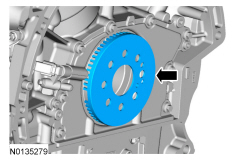
NOTE: Install the engine stand bolts into the cylinder block only. Do not install the bolts into the oil pan.
Mount the engine on a suitable engine stand.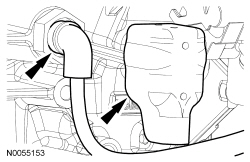
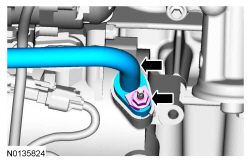
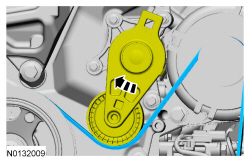
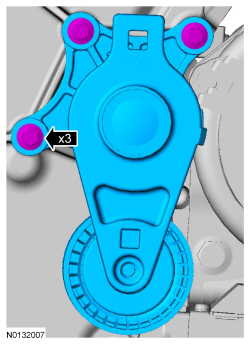
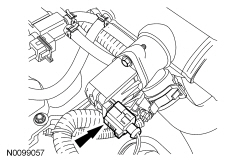
NOTE: Index-mark the hoses for installation.
Remove the turbocharger wastegate regulating valve hoses from the RH CAC tube and turbocharger wastegate regulating valve.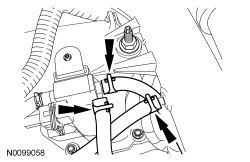
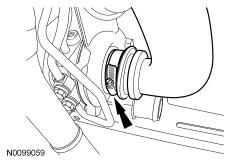
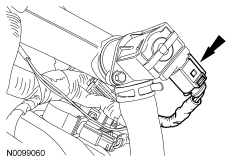
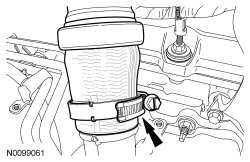
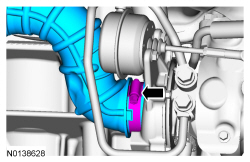
NOTICE: The compression limiter bushing may fall out of the mounting bracket grommet on the turbocharger intake tube during service. Make sure the bushing is in place when reinstalling the tube or damage to the tube may occur.
Remove the nut from the RH valve cover stud bolt for the RH turbocharger intake tube.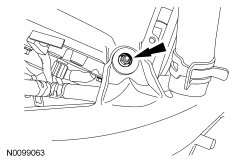
NOTICE: The compression limiter bushing may fall out of the mounting bracket grommet on the Charge Air Cooler (CAC) tube during service. Make sure the bushing is in place when reinstalling the tube or damage to the tube may occur.
Remove the RH CAC tube nut from the intake manifold and remove the RH CAC tube and turbocharger intake tube as an assembly.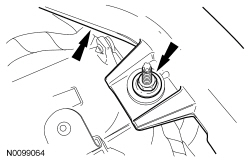
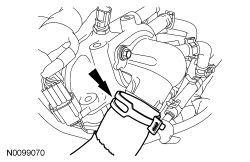
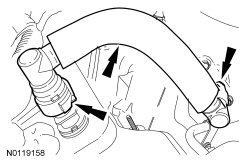
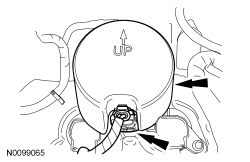
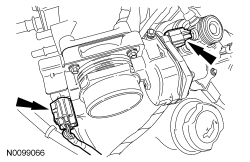
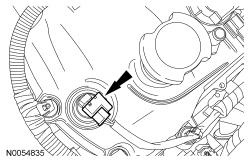
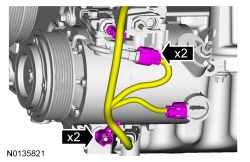
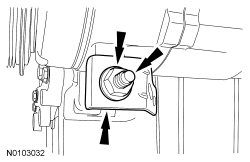
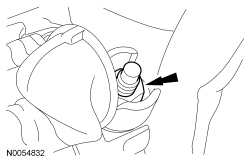
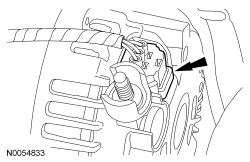
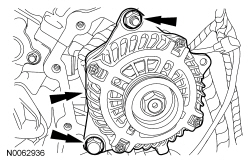
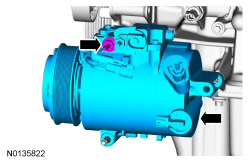
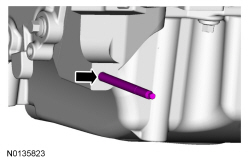
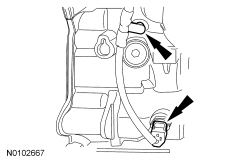
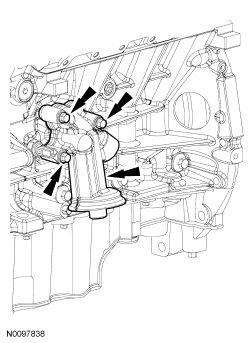
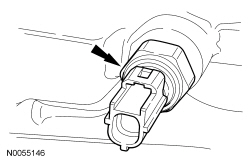
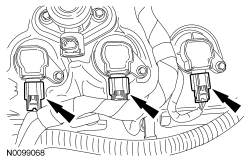

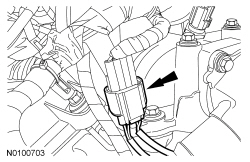
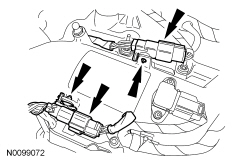
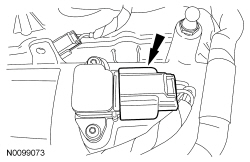
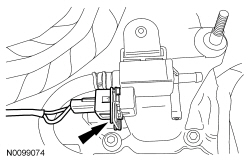
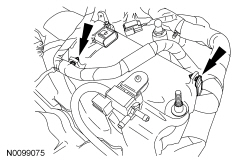
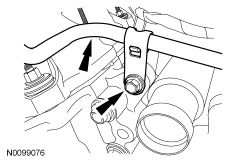
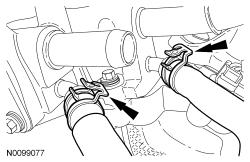
NOTICE: If the engine is repaired or replaced because of upper engine failure, typically including valve or piston damage, check the intake manifold for metal debris. If metal debris is found, install a new intake manifold. Failure to follow these instructions can result in engine damage.
NOTE: Note the routing of the 2 fuel rail wiring harnesses for installation.
Remove the 12 bolts and the intake manifold.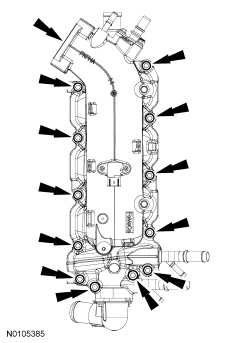
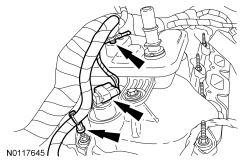
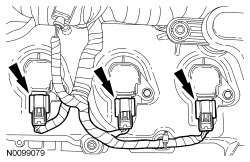
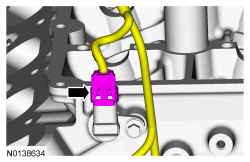
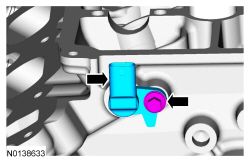
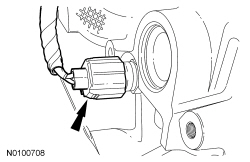
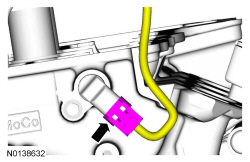
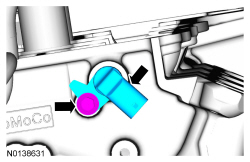
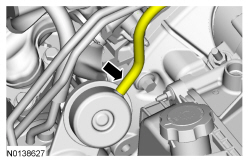
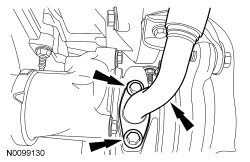
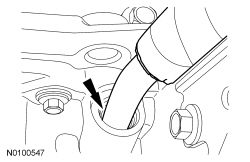
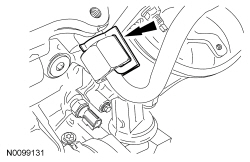
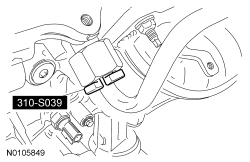
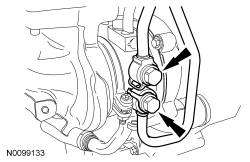
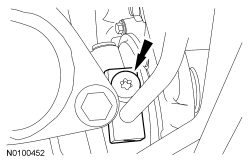
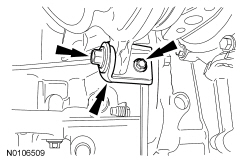
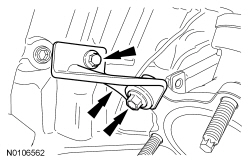
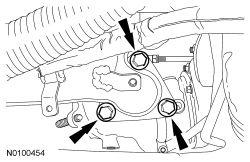
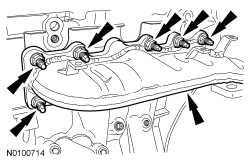
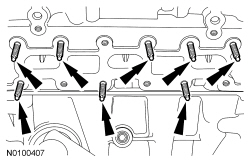
NOTICE: Do not use metal scrapers, wire brushes, power abrasive discs or other abrasive means to clean the sealing surfaces. These may cause scratches and gouges resulting in leak paths. Use a plastic scraper to clean the sealing surfaces.
Clean the exhaust manifold mating surface of the cylinder head with metal surface prep. Follow the directions on the packaging.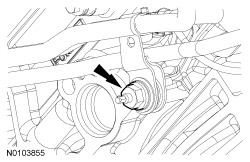
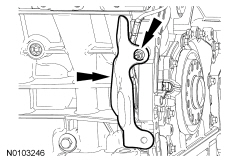

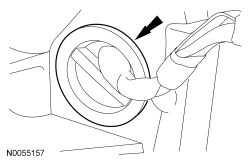
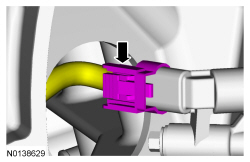
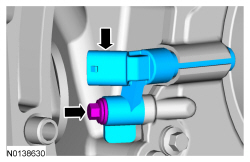
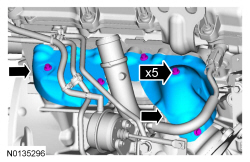
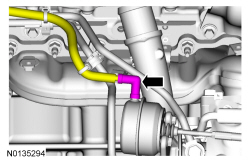
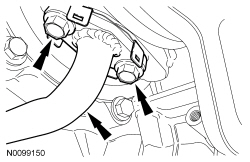
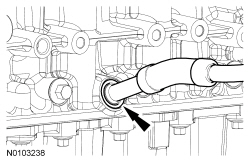
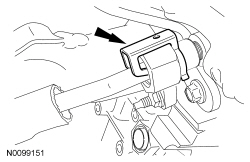
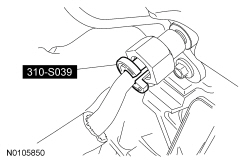
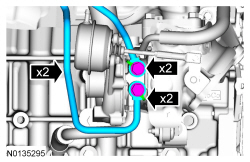
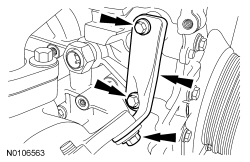
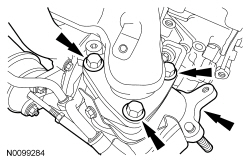
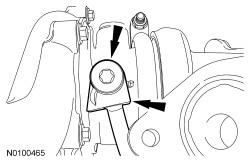
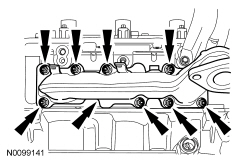
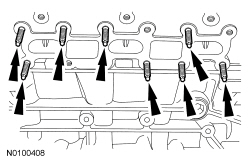
NOTICE: Do not use metal scrapers, wire brushes, power abrasive discs or other abrasive means to clean the sealing surfaces. These may cause scratches and gouges resulting in leak paths. Use a plastic scraper to clean the sealing surfaces.
Clean the exhaust manifold mating surface of the cylinder head with metal surface prep. Follow the directions on the packaging.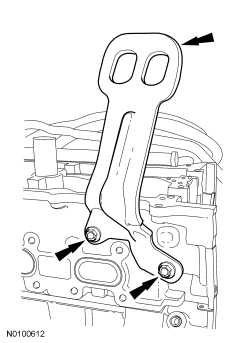
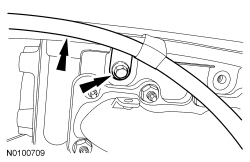
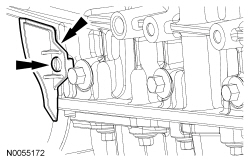
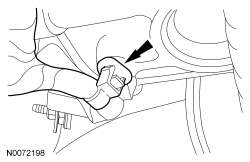
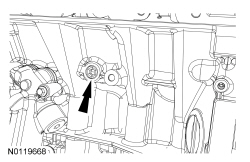
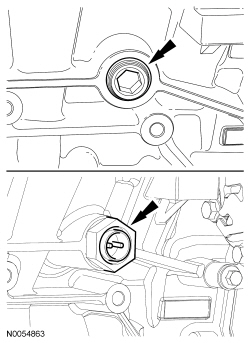
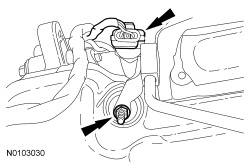
NOTE: To release the fuel pressure in the high pressure fuel tube, wrap the flare nut with a shop towel to absorb any residual fuel pressure during the loosening of the flare nut.
Remove the high pressure fuel tube flare nut from the fuel injection pump. Remove the 2 high pressure fuel tube flare nuts from the fuel rails and remove the high pressure fuel tube assembly.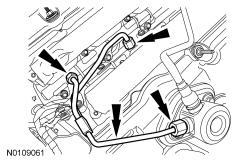
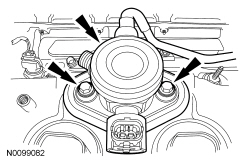
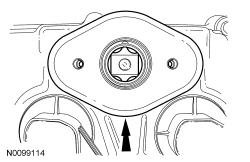
NOTE: Valve cover is removed for clarity.
Remove the fuel injection pump roller tappet.
NOTICE: It is very important to note the routing of the wiring harness on the fuel rails and index-mark the locations of the tie straps prior to removal or damage may occur to the wire harnesses during installation. The illustration details the correct wire harness routing and tie strap positioning for installation.
NOTE: Use compressed air to remove any dirt or foreign material from the cylinder head, block and the general surrounding area of the fuel rails and injectors.
Carefully cut and remove the fuel rail wire harness tie straps.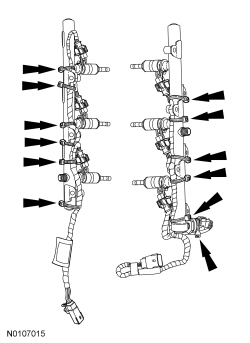
NOTICE: Pull out the fuel rails in the direction of the fuel injector axis or damage may occur to the fuel injectors.
NOTE: When removing the fuel rails, the fuel injectors may remain in the fuel rails but normally remain lodged in the cylinder heads and require the use of a Fuel Injector Remover to extract.
Remove the 6 bolts and the LH fuel rail.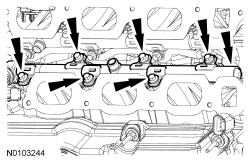

NOTE: RH shown, LH similar.
Disconnect the 6 fuel injector electrical connectors and remove the 2 fuel injector wire harnesses.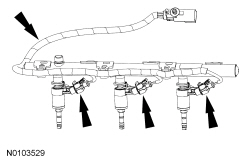
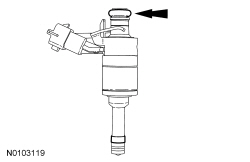
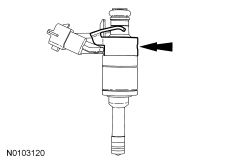
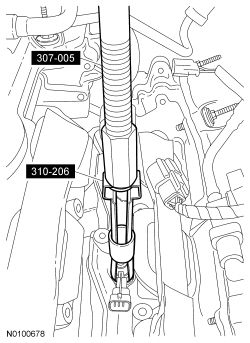
NOTE: When removing the ignition coil-on-plugs, a slight twisting motion will break the seal and ease removal.
Remove the 3 bolts and the 3 RH ignition coils-on-plugs.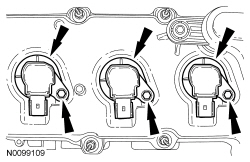
NOTE: When removing the ignition coil-on-plugs, a slight twisting motion will break the seal and ease removal.
Remove the 3 bolts and the 3 LH ignition coils-on-plugs.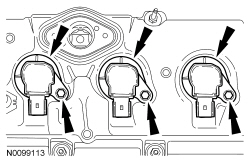
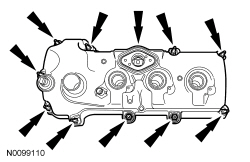
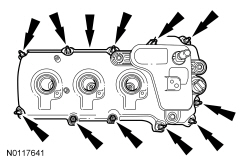
NOTE: VCT solenoid seal removal shown, spark plug tube seal removal similar.
Inspect the VCT solenoid seals and the spark plug tube seals. Install new seals if damaged.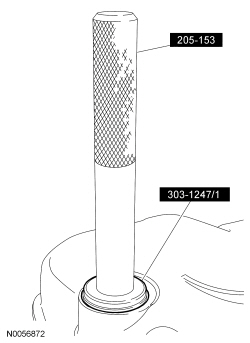
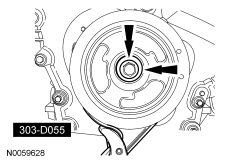
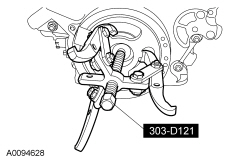
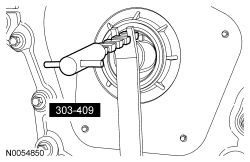
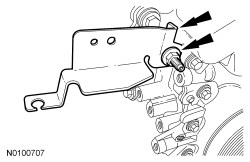
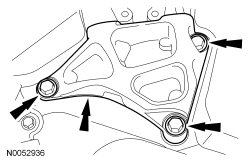
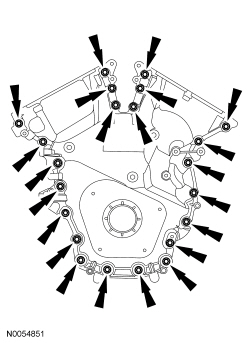
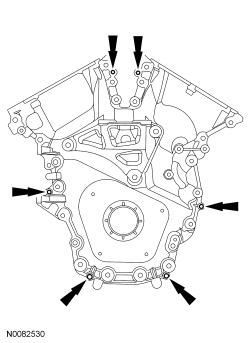
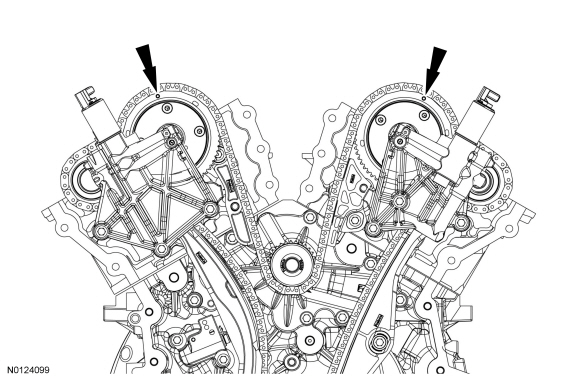
NOTE: The Camshaft Holding Tool will hold the camshafts in the Top Dead Center (TDC) position.
Install the Camshaft Holding Tool onto the flats of the LH camshafts.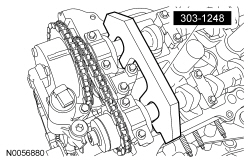
NOTE: The Camshaft Holding Tool will hold the camshafts in the TDC position.
Install the Camshaft Holding Tool onto the flats of the RH camshafts.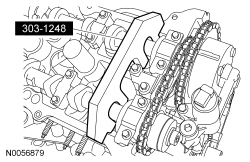
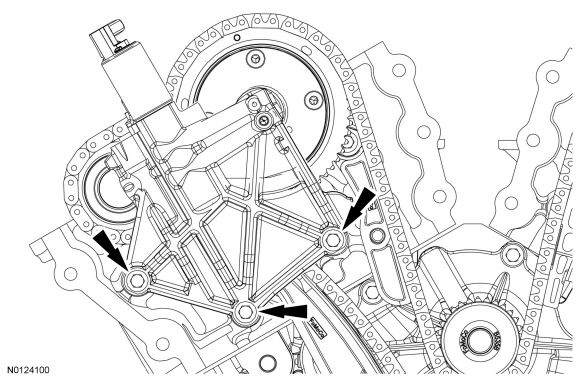
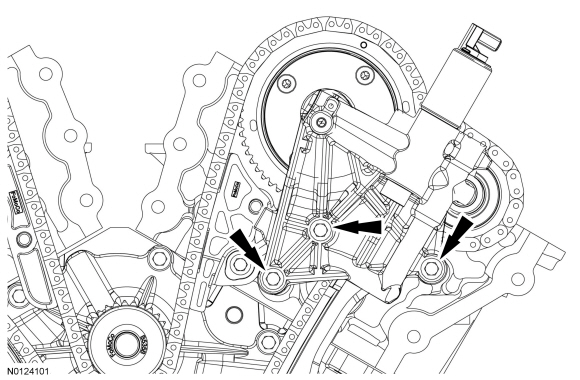
NOTE: The following 3 steps are for primary timing chains when the colored links are not visible.
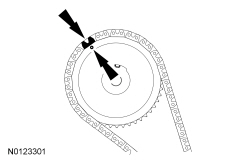
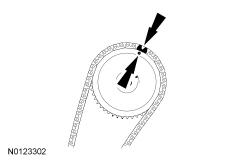
NOTE: The crankshaft sprocket timing mark should be between the 2 colored links.
Mark the 2 timing chain links that align with the timing mark on the crankshaft sprocket as shown.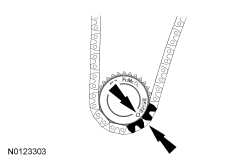
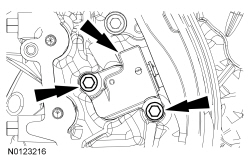
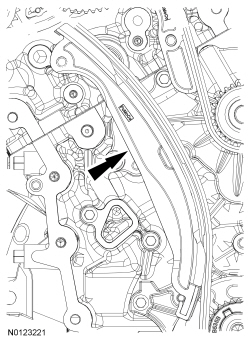
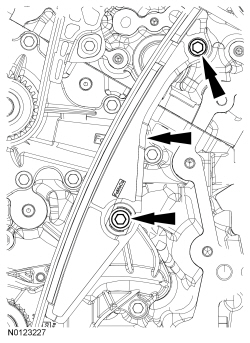
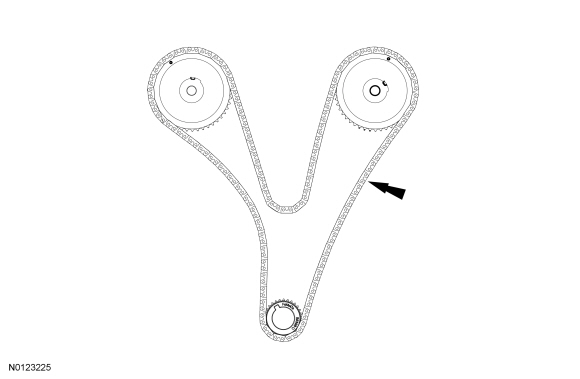
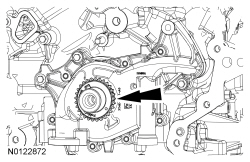
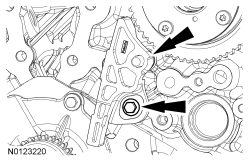
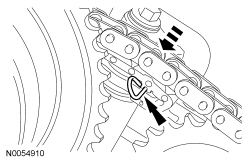
NOTE: The VCT bolt and the exhaust camshaft bolt must be discarded and new ones installed. However, the exhaust camshaft washer is reusable.
Remove and discard the LH VCT assembly bolt and the LH exhaust camshaft sprocket bolt.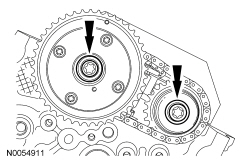
NOTE: When the Camshaft Holding Tool is removed, valve spring pressure will rotate the LH camshafts approximately 3 degrees to a neutral position.
Remove the Camshaft Holding Tool from the LH camshafts.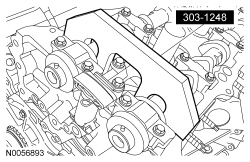
NOTICE: The camshafts must remain in the neutral position during removal or engine damage may occur.
Verify the LH camshafts are in the neutral position.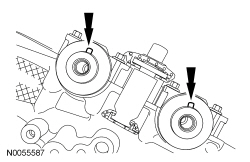
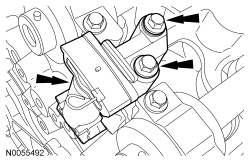
NOTE: Cylinder head camshaft bearing caps are numbered to verify that they are assembled in their original positions.
Remove the bolts and the LH camshaft bearing caps.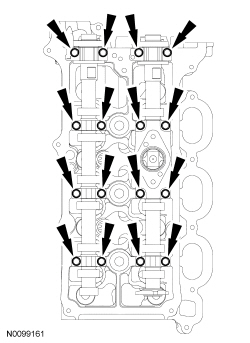
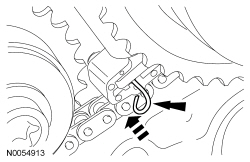
NOTE: The VCT bolt and the exhaust camshaft bolt must be discarded and new ones installed. However, the exhaust camshaft washer is reusable.
Remove and discard the RH VCT assembly bolt and the RH exhaust camshaft sprocket bolt.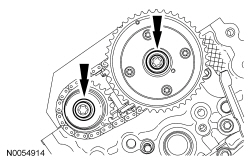
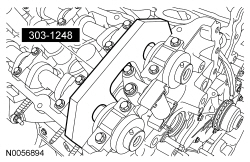
NOTICE: The camshafts must remain in the neutral position during removal or engine damage may occur.
Rotate the RH camshafts counterclockwise to the neutral position.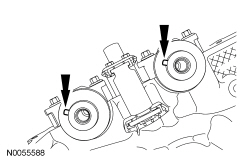
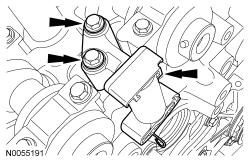
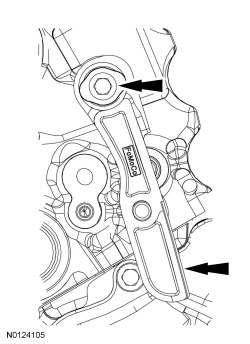
NOTE: Cylinder head camshaft bearing caps are numbered to verify that they are assembled in their original positions.
Remove the bolts and the RH camshaft bearing caps.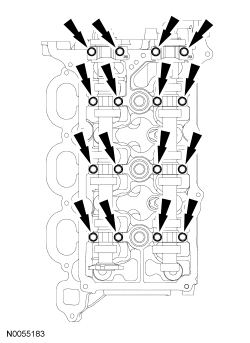
NOTE: If the components are to be reinstalled, they must be installed in the same positions. Mark the components for installation into their original locations.
NOTE: LH shown, RH similar.
Remove the valve tappets from the cylinder heads.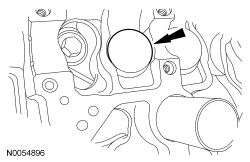
NOTE: LH shown, RH similar.
Remove and discard the M6 bolt from each cylinder head.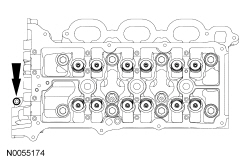
NOTICE: Place clean, lint-free shop towels over exposed engine cavities. Carefully remove the towels so foreign material is not dropped into the engine. Any foreign material (including any material created while cleaning gasket surfaces) that enters the oil passages or the oil pan, may cause engine failure.
NOTICE: Aluminum surfaces are soft and may be scratched easily. Never place the cylinder head gasket surface, unprotected, on a bench surface.
NOTE: The cylinder head bolts must be discarded and new bolts must be installed. They are a torque-to-yield design and cannot be reused.
NOTE: LH shown, RH similar.
Remove and discard the 8 bolts from each cylinder head.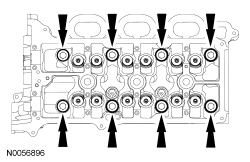
NOTICE: Do not use metal scrapers, wire brushes, power abrasive discs or other abrasive means to clean the sealing surfaces. These tools cause scratches and gouges that make leak paths. Use a plastic scraping tool to remove all traces of the head gasket.
NOTE: Observe all warnings or cautions and follow all application directions contained on the packaging of the silicone gasket remover and the metal surface prep.
NOTE: If there is no residual gasket material present, metal surface prep can be used to clean and prepare the surfaces.
Clean the cylinder head-to-cylinder block mating surfaces of both the cylinder heads and the cylinder block in the following sequence.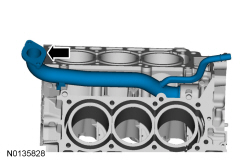
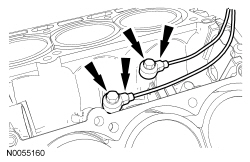
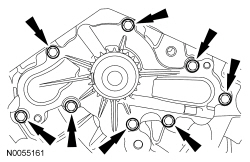
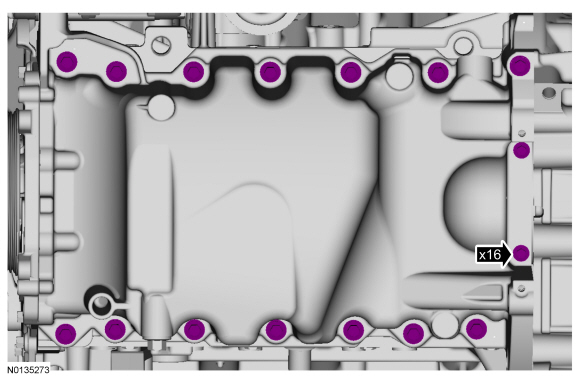
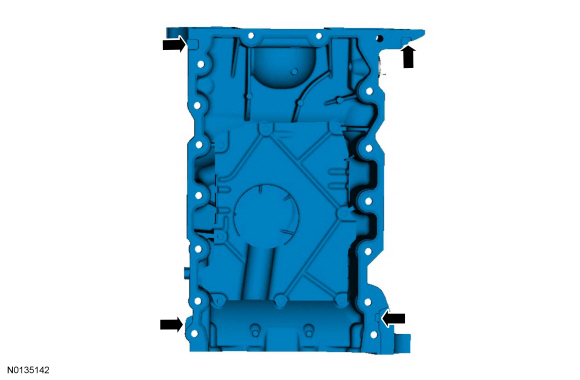
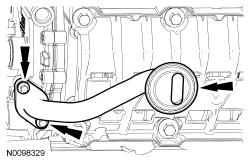
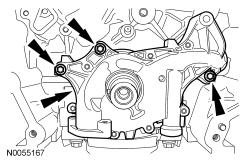
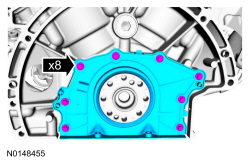
NOTICE: Only use a 3M™ Roloc® Bristle Disk (2-in white, part number 07528) to clean the engine front cover, oil pan and crankshaft rear seal retainer plate. Do not use metal scrapers, wire brushes or any other power abrasive disk to clean the engine front cover and oil pan. These tools cause scratches and gouges that make leak paths.
Clean the engine front cover and oil pan using a 3M™ Roloc® Bristle Disk (2-in white, part number 07528) in a suitable tool turning at the recommended speed of 15,000 rpm.NOTE: The main bearing cap support brace bolts must be discarded and new bolts must be installed. They are a tighten-to-yield design and cannot be reused.
Remove the bolts in the sequence shown.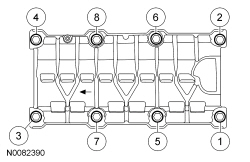
NOTE: The connecting rod cap bolts are a torque-to-yield design. The original connecting rod cap bolts will be used when measuring the connecting rod large end bore during assembly. The connecting rod cap bolts will be discarded after measurement.
NOTE: Clearly mark the position and orientation of the connecting rods, connecting rod caps and connecting rod bearings for reassembly.
Remove the connecting rod cap bolts and cap.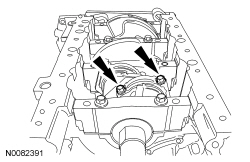
NOTICE: Do not scratch the cylinder walls or crankshaft journals with the connecting rod.
Remove the piston/rod assembly from the engine block.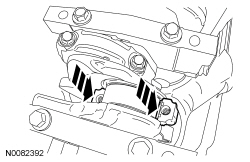
NOTE: The 8 main bearing cap side bolts and the 8 main bearing cap bolts must be discarded and new bolts must be installed. They are a tighten-to-yield design and cannot be reused.
NOTE: Clearly mark the position and orientation of the main bearing caps for reassembly.
Remove the 8 main bearing cap side bolts and the 8 main bearing cap bolts in the sequence shown.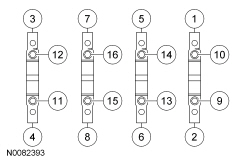
NOTE: If the main bearings are being reused, mark them for correct position and orientation for reassembly.
NOTE: Note the position of the thrust washer on the outside of the No. 4 rear main bearing cap.
Remove the 4 main bearing caps.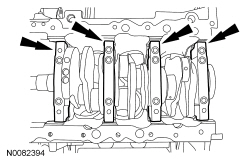
NOTE: Note the position of the 2 thrust washers on the inside and outside of the rear main bearing bulkhead.
Remove the crankshaft.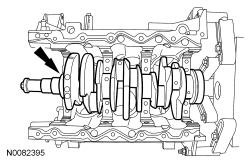
NOTE: Inside shown, outside similar.
Remove the 2 crankshaft thrust bearings from the rear main bearing bulkhead.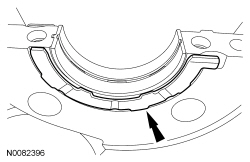
NOTE: If the main bearings are being reused, mark them for correct position and orientation for reassembly.
Remove the 4 crankshaft main bearings from the cylinder block.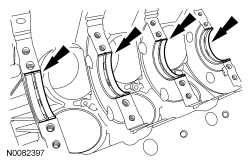
NOTE: If the main bearings are being reused, mark them for correct position and orientation for reassembly.
Remove the 4 crankshaft main bearings from the main bearing caps.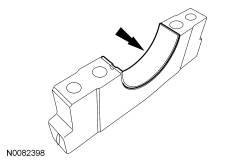
NOTICE: Place clean, lint-free shop towels over exposed engine cavities. Carefully remove the towels so foreign material is not dropped into the engine. Any foreign material (including any material created while cleaning gasket surfaces) that enters the oil passages or the oil pan, may cause engine failure.
NOTICE: Do not use wire brushes, power abrasive discs or 3M™ Roloc® Bristle Disk (2-in white, part number 07528) to clean the sealing surfaces. These tools cause scratches and gouges that make leak paths. They also cause contamination that will cause premature engine failure. Remove all traces of sealant.
Clean the sealing surfaces of the cylinder block in the following sequence.